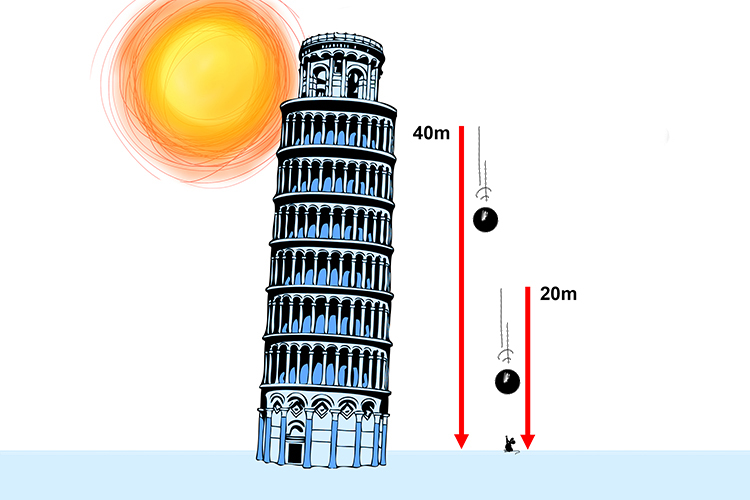Gravitational potential energy
Gravitational potential energy is the energy possessed by an object due to its position in a gravitational field. The formula for calculating gravitational potential energy is:
Gravitational potential energy = mass x gravitational field strength x height moved


Gold plate even my grand house
Gravitational potential energy is measured in Joules (J). To remember this, think of the following image:

Everything was gold plated but my jewels.
NOTE:
An object's gravitational potential energy is converted to other forms of energy (usually kinetic energy) as gravity pulls the object towards the centre of the gravitational field.
For example, when a ball is dropped from a tower, it falls towards the ground (towards the centre of the gravitational field). The ball's gravitational potential energy is reduced as it falls, but its kinetic energy (movement) increases.

Above: when a 1kg ball is released at the top of the tower it has 0 kinetic energy but has a gravitational potential energy of GPE = 1 x 10 x 40 = 400J.
But by the time the ball has fallen to 20m above the ground, its GPE = 1 x 10 x 20 = 200J, meaning it will have gained 200J of kinetic energy by this point.
As the ball hits the ground, all of the gravitational potential energy it had at the top of the tower will have been converted to kinetic energy.
Example 1
An owl has a mass of 4kg. It dives to catch a mouse, losing 800 Joules of gravitational potential energy. Assuming acceleration due to gravity to be 10 m/s2 how high was the bird to begin with?
Answer
Gravitational potential energy = mass x gravitational field strength x height moved
800 = 4 x 10 x owl's change in height
Divide both sides by 4 x 10 to make owl's change in height the subject,
\frac{800}{4\ \times10}\ =\ \frac{\strike{4\ \times10\ }\times Owl's\ change\ in\ height}{\strike{4\ \times10}}
Owl's\ change\ in\ height\ \frac{800}{4\ \times\ 10}\ =\ \frac{800}{40}=\ 20m
Example 2
An astronaut wearing his suit has a total mass of 110kg. On the moon, he climbs into his spacecraft 5m up a ladder. This increases his GPE by 880 Joules. What is the strength of gravity on the moon?
Note
Gravity can be measured in N/kg but can also be given as m/s2 (metres per second squared). However, if the question asks for the gravitational field strength you should give your answer as N/kg and if it asks for the acceleration due to gravity then your answer should be given as m/s2.
Answer
Gravitational potential energy = mass x gravitational field strength x height moved
880 = 110 x gravity x 5
880 = 110 x 5 x gravity
Divide both sides by 110 x 5 to make gravity the subject,
\ \frac{880}{110\times5}\ =\ \frac{\strike{110\times5\ }\times gravity\ }{\strike{110\ \times5}}
gravity\ =\ \frac{880}{110\times5\ }=1.6N/kg
Example 3
|
Object |
Mass of object |
|
Elephant |
5 tonnes |
|
Person |
80 Kg |
Elephants don’t jump. But if they could how much more gravitational energy would one have if it jumped 30cm compared to a person who jumped the same height? Assuming acceleration due to gravity is 10m/s2.
Answer
To answer this you must first convert the mass of the elephant and the height it jumps into standard units required for use in the formula. So 5 tonnes = 5000kg and 30 cm = 0.3 m.
Gravitational potential energy = mass x gravitational field strength x height moved
GPE = mgh
Gravitational potential energy of elephant = 5000 x 10 x 0.3 = 15,000 Joules
Gravitational potential energy of person = 80 x 10 x 0.3 = 240 Joules
15,000 – 240 = 14760 Joules is how much more gravitational potential energy the elephant has compared to a person.




